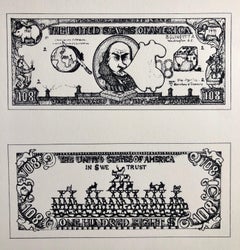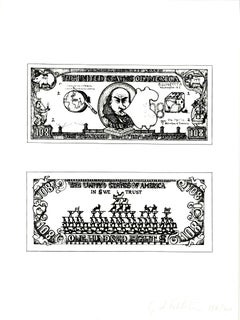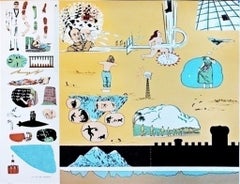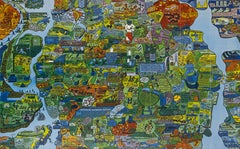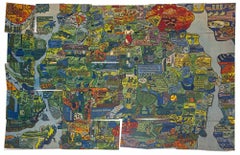Oyvind Fahlstrom Art
to
5
5
4
4
1
1
1960's Pop Art Silkscreen Print 108$ Bill Inflation Hand Signed and Numbered
By Oyvind Fahlstrom
Located in Surfside, FL
Öyvind Axel Christian Fahlström (1928–1976) was a Swedish Multimedia artist.
Fahlström was born in Sao Paulo, Brazil, In July 1939 he was sent to Stockholm to visit some distant relatives and after World War II he started to study and later on to work as a writer, critic and journalist. From 1960 until 1976 he was married to the Swedish Pop Art painter Barbro Östlihn.
In 1953 Fahlström had his first solo exhibition, showing the drawing Opera, a room-sized felt-pen drawing. Also in 1953 he wrote Hätila ragulpr på fåtskliaben, a manifesto for concrete poetry, published in Swedish the following year and in English translation (by Mary Ellen Solt, in her anthology "Concrete Poetry. A world view") in 1968.
In 1956 Fahlström moved to Paris and lived there for three years before he moved to Front Street studio, New York City. In New York he worked with different artists and explored his role as an artist further. In 1962 he participated in the New Realists exhibition at the Sidney Janis Gallery, in New York City. His work was included in the 1964 Venice Biennale and he had a solo exhibition at Cordier & Ekstrom Inc., New York. In 1965 he joined the Sidney Janis Gallery.
In 1966 his work Performance of Kisses Sweeter Than Wine was included in 9 Evenings: Theatre and Engineering, organized by Experiments in Art and Technology at the 26th Street Armory, New York. The same year his painting in oil on photo...
Category
1970s Pop Art Oyvind Fahlstrom Art
Materials
Lithograph, Screen
One Hundred and Eight Inflated Dollars, from Sonnabend and Castelli Collection
By Oyvind Fahlstrom
Located in New York, NY
Öyvind Fahlström
One Hundred and Eight Inflated Dollars, from the Collection of Ileana Sonnabend and the Estate of Nina Castelli, 1973
Lithograph on rag paper. Signed. Numbered. in o...
Category
1970s Contemporary Oyvind Fahlstrom Art
Materials
Rag Paper, Lithograph
Eddie (Sylvie's Brother) in the Desert (celebrated 1960s silkscreen) Signed/N
By Oyvind Fahlstrom
Located in New York, NY
Öyvind Fahlström
Eddie (Sylvie's Brother) in the Desert (from New York International Portfolio), 1966
Silkscreen on wove paper
Pencil signed and numbered from the limited edition of ...
Category
1960s Pop Art Oyvind Fahlstrom Art
Materials
Screen, Pencil, Graphite
Section of Word Map-A Puzzle
By Oyvind Fahlstrom
Located in New York, NY
This lithograph by Oyvind Fahlstrom, produced in an edition of 100, is offered by CLAMP in New York City.
Category
1970s Contemporary Oyvind Fahlstrom Art
Materials
Lithograph
Sketch for World Map from the Peace Portfolio, Silkscreen by Oyvind Fahlstrom
By Oyvind Fahlstrom
Located in Long Island City, NY
Artist: Oyvind Fahlstrom, Swedish (1928 - 1976)
Title: Sketch for World Map from the Peace Portfolio
Year: 1972
Medium: Silkscreen, signed and numbere...
Category
1970s Pop Art Oyvind Fahlstrom Art
Materials
Screen
Related Items
Mini Fab - Pride by Gavin Dosbon, Limited edition print, Hand made print
By Gavin Dobson
Located in Deddington, GB
Mini Fab – Pride [2022]
limited_edition and hand signed by the artist
Cymk screen print and glitter
Edition number 100
Image size: H:21 cm x W:14.8 cm
Complete Size of Unframed Work...
Category
21st Century and Contemporary Pop Art Oyvind Fahlstrom Art
Materials
Screen, Paper, Glitter, Mixed Media
H 8.27 in W 5.83 in D 0.4 in
Yes You Can Can
Located in Deddington, GB
Yes You Can Can (Splats Edition) by Amy Gardner [2020]
limited_edition
Screen Print, Watercolour
Edition number 40
Image size: H:50 cm x W:50 cm
Sold Unframed
Please note that insitu images are purely an indication of how a piece may look
Only AP works left in this edition. This print is about women supporting women. 'YES YOU CAN CAN' splats edition limited edition of 40 Archival Bread & Butter bright white paper 270gsm 50x 50cms 5 screen...
Category
21st Century and Contemporary Pop Art Oyvind Fahlstrom Art
Materials
Paper, Watercolor, Screen
Deborah Kass Feminist Jewish American Pop Art Silkscreen Screenprint Ltd Edition
By Deborah Kass
Located in Surfside, FL
Deborah Kass (born 1952)
Being Alive, 2012
nine-color silkscreen, one color blend on 2-ply museum board
Image 24 x 24 image. Frame 29 x 29 x 2 inches
Edition 1/65
Hand signed and dated in pencil, lower right verso; numbered lower left verso
Being Alive is from a vibrant and uplifting body of work entitled Feel Good Paintings for Feel Bad Times. Finding inspiration in pop culture, political realities, film, Yiddish, art historical styles, and prominent art world figures, Deborah Kass uses appropriation in her work to explore notions of identity, politics, and her own cultural interests. She received her BFA in painting at Carnegie Mellon University and studied at the Whitney Museum Independent Study Program and the Art Students League of New York.
Deborah Kass (born 1952) is an American artist whose work explores the intersection of pop culture, art history, and the construction of self. Deborah Kass works in mixed media, and is most recognized for her paintings, prints, photography, sculptures and neon lighting installations. Kass's early work mimics and reworks signature styles of iconic male artists of the 20th century including Frank Stella, Andy Warhol, Jackson Pollock, and Ed Ruscha. Kass's technique of appropriation is a critical commentary on the intersection of social power relations, identity politics, and the historically dominant position of male artists in the art world.
Deborah Kass was born in 1952 in San Antonio, Texas. Her grandparents were from Belarus and Ukraine, first generation Jewish immigrants to New York. Kass's parents were from the Bronx and Queens, New York. Her father did two years in the U.S. Air Force on base in San Antonio until the family returned to the suburbs of Long Island, New York, where Kass grew up. Kass’s mother was a substitute teacher at the Rockville Centre public schools and her father was a dentist and amateur jazz musician.
At age 14, Kass began taking drawing classes at The Art Students League in New York City which she funded with money she made babysitting. In the afternoons, she would go to theater on and off Broadway, often sneaking for the second act. During her high school years, she would take her time in the city to visit the Museum of Modern Art, where she would be exposed to the works of post-war artists like Frank Stella and Willem De Kooning. At age 17, Stella’s retrospective exhibition inspired Kass to become an artist as she observed and understood the logic in his progression of works and the motivation behind his creative decisions.
Kass received her BFA in Painting at Carnegie Mellon University (the alma mater of artist Andy Warhol), and studied at the Whitney Museum Independent Study Program Here, she created her first work of appropriation, Ophelia’s Death After Delacroix, a six by eight foot rendition of a small sketch by the French Romantic artist, Eugène Delacroix.
At the same time Neo-Expressionism was being helmed by white men in the late Reagan years, women were just beginning to create a stake in the game for critical works. “The Photo Girls” consisted of artists like Sherrie Levine, Cindy Sherman, and Barbara Kruger. Kass felt that content of these works connected those of the post-war abstract painters of the mid-70s including Elizabeth Murray, Pat Steir, and Susan Rothenberg. All of these artists critically explored art in terms of new subjectivities from their points-of-view as women. Kass took from these artists the ideas of cultural and media critique, inspiring her Art History Paintings.
Kass is most famous for her “Decade of Warhol,” in which she appropriated various works by the pop artist, Andy Warhol. She used Warhol’s visual language to comment on the absence of women in art history at the same time that Women’s Studies began to emerge in academia. Reading texts on subjectivity, objectivity, specificity, and gender fluidity by theorists like Judith Butler and Eve Sedgwick, Kass became literate in ideas surrounding identity. She engaged with art history through the lens of feminism, because of this theory which “The Photo Girls” drew upon.
Kass's work is in the collections of the Museum of Modern Art; Whitney Museum of American Art; Solomon R. Guggenheim Museum; Jewish Museum (New York); Museum of Fine Art, Boston; Cincinnati Museum of Art; New Orleans Museum; National Portrait Gallery, Smithsonian Institution; Fogg Museum, Harvard Art Museums; and Weatherspoon Museum, among others.
In 2012 Kass's work was the subject of a mid-career retrospective Deborah Kass, Before and Happily Ever After at The Andy Warhol Museum in Pittsburgh, PA. An accompanying catalogue published by Skira Rizzoli, included essays by noted art historians Griselda Pollock, Irving Sandler, Robert Storr, Eric C. Shiner and writers and filmmakers Lisa Liebmann, Brooks Adams, and John Waters.
Kass's work has been shown at international private and public venues including at the Venice Biennale, the Istanbul Biennale, the Museum Ludwig, Cologne, the Museum of Modern Art, The Jewish Museum, New York, the National Portrait Gallery, and the Museum of Fine Arts, Boston. A survey show, Deborah Kass, The Warhol Project traveled across the country from 1999–2001. She is a Senior Critic in the Yale University M.F.A. Painting Program.
Kass's later paintings often borrow their titles from song lyrics. Her series feel good paintings for feel bad times, incorporates lyrics borrowed from The Great American Songbook, which address history, power, and gender relations that resonate with Kass's themes in her own work.
In Kass's first significant body of work, the Art History Paintings, she combined frames lifted from Disney cartoons with slices of painting from Pablo Picasso, Jasper Johns, Jackson Pollock, and other contemporary sources. Establishing appropriation as her primary mode of working, these early paintings also introduced many of the central concerns of her work to the present. Before and Happily Ever After, for example, coupled Andy Warhol’s painting of an advertisement for a nose job with a movie still of Cinderella fitting her foot into her glass slipper, touching on notions of Americanism and identity in popular culture. The Art History Paintings series engages critically with the history of politics and art making, especially exploring the power relationship of men and women in society. Deborah Kass's work reveals a personal relationship she shares with particular artworks, songs and personalities, many of which are referenced directly in her paintings.
In 1992, Kass began The Warhol Project. Beginning in the 1960s, Andy Warhol’s paintings employed mass production through screen-printing to depict iconic American products and celebrities. Using Warhol’s stylistic language to represent significant women in art, Kass turned Warhol’s relationship to popular culture on its head by replacing them with subjects of her own cultural interests. She painted artists and art historians that were her heroes including Cindy Sherman, Elizabeth Murray, and Linda Nochlin. Drawing upon her childhood nostalgia, the Jewish Jackie series depicts actress Barbra Streisand, a celebrity with whom she closely identifies, replacing Warhol's prints of Jackie Kennedy Onassis and Marilyn Monroe. Her My Elvis series likewise speaks to gender and ethnic identity by replacing Warhol's Elvis with Barbra Streisand from Yentl: a 1983 film in which Streisand plays a Jewish woman who dresses and lives as a man in order to receive an education in the Talmudic Law. Kass's Self Portraits as Warhol further deteriorates the idea of rigid gender norms and increasingly identifies the artist with Warhol. By appropriating Andy Warhol's print Triple Elvis and replacing Elvis Presley with Barbara Streisand’s Yentl, Kass is able to identify herself with history’s icons, creating a history with powerful women as subjects of art. The work embodies her concerns surrounding gender representation, advocates for a feminist revision of art, and directly challenges the tradition of patriarchy.
America's Most Wanted is a series of enlarged black-and-white screen prints of fake police mug shots. The collection of prints from 1998–1999 is a late-1990s update of Andy Warhol’s 1964 work 13 Most Wanted Men, which featured the most wanted criminals of 1962. The “criminals” are identified in titles only by first name and surname initial, but in reality the criminals depicted are individuals prominent in today's art world. Some of the individuals depicted include Donna De Salvo, deputy director for international initiatives and senior curator at the Whitney Museum of American Art; Thelma Golden, director and chief curator of the Studio Museum in Harlem, and Robert Storr, dean of the Yale School of Art. Kass's subjects weren’t criminals. Through this interpretation, Kass show's how they are wanted by aspirants for their ability to elevate artists’ careers. The series explores the themes of authorship and the gaze, at the same time problematizing certain connotations within the art world.
In 2002, Kass began a new body of work, feel good paintings for feel bad times, inspired, in part, by her reaction to the Bush administration. These works combine stylistic devices from a wide variety of post-war painting, including Ellsworth Kelly, Frank Stella, Jackson Pollock, Andy Warhol, and Ed Ruscha, along with lyrics by Stephen Sondheim, Laura Nyro, and Sylvester, among others, pulling from popular music, Broadway show tunes, the Great American Songbook, Yiddish, and film. The paintings view American art and culture of the last century through the lens of that time period's outpouring of creativity that was the result of post-war optimism, a burgeoning middle class, and democratic values. Responding to the uncertain political and ecological climate of the new century in which they have been made, Kass's work looks back on the 20th century critically and simultaneously with great nostalgia, throwing the present into high relief. Drawing, as always, from the divergent realms of art history, popular culture, political realities, and her own political and philosophical reflection, the artist continues into the present the explorations that have characterized her paintings since the 1980s in these new hybrid textual and visual works.
OY/YO
In 2015, Two Tree Management Art in Dumbo commissioned of a monumentally scaled installation of OY/YO for the Brooklyn Bridge Park. The sculpture, measuring 8×17×5 ft., consists of big yellow aluminum letters, was installed on the waterfront and was visible from the Manhattan. It spells “YO” against the backdrop of Brooklyn. The flip side, for those gazing at Manhattan, reads “OY.”[ An article and photo appeared on the front page of the New York Times 3 days after its installation in the park. An instant icon, OY/YO stayed at that site for 10 months where it became a tourist destination, a favorite spot for wedding, graduation, class photos and countless selfies. After its stay in Dumbo it moved to the ferry stop at North 6th Street in Williamsburg, Brooklyn for a year, where it greeted ferry riders. Since 2011, OY/YO has been a reoccurring motif in Deborah Kass's work in the form of paintings, prints, and tabletop sculptures. Kass first created “OY” as a painting riffing on Edward Ruscha’s 1962 Pop canvas, “OOF.” She later painted “YO” as a diptych that nodded to Picasso's 1901 self-portrait, “Yo Picasso” (“I, Picasso”). OY/YO is now installed in front of the Brooklyn Museum. Another arrived at Stanford University in front of the Cantor Arts Center late 2019. A large edition of OY/YO was acquired by the Jewish Museum in New York in 2017 and is on view in the exhibition Scenes from the Collection.
On December 9, 2015 Deborah Kass introduced her new paintings that incorporated neon lights in an exhibition at Paul Kasmin Gallery entitled "No Kidding" in Chelsea, New York. The exhibition was an extension of her Feel Good Paintings for Feel Bad Times, but it sets a darker, tougher tone as she reflects on contemporary issues such as global warming, institutional racism, political brutality, gun violence, and attacks on women's health, through the lens of minimalism and grief. The series is ongoing.
Deborah Kass has spoken about creating an “ode to the great Louises,” a space dedicated to her works inspired by famous Louise’s which she would call the “Louise Suite.” The earliest of these odes is “Sing Out Louise,” a 2002 oil on linen painting from her Feel Good Paintings Feel Bad Times collection. “Sing out Louise” is driven by her fondness for Rosalind Russel and the fact Kass feels it is her time to “Sing Out] “After Louise Bourgeois” is a 2010 sculpture made of neon and transformers on powder-coated aluminum monolith; it is a spiraling neon light with a phrase inspired by French-American artist Louise Bourgeois.[22] The neon installation reads “A woman has no place in the art world unless she proves over and over again that she won’t be eliminated.” Kass changed the quote slightly to better represent her beliefs but it was derived from Bourgeois. “After Louise Nevelson” is a 2020 spiraling neon work of art that reads "Anger? I'd be dead without my anger" a quote from American sculptor, Louise Nevelson.
Award and Grants
New York Foundation for the Arts, inducted into NYFA Hall of Fame (2014)
Art Matters Inc. Grant (1996)
Art Matters Inc. Grant (1992)
New York Foundation for the Arts, Fellowship in Painting 1987 National Endowment for the Arts, Painting (1991)
National Endowment For The Arts (1987)
Selected solo and group exhibitions
The Jewish Museum, New York, NY, “Scenes from the Collection”
National Portrait Gallery, Washington, DC “Eye Pop: the Celebrity Gaze”
Paul Kasmin Gallery, New York, NY, “No Kidding” (2015-2016)
Sargent...
Category
2010s Pop Art Oyvind Fahlstrom Art
Materials
Screen
Montreux Jazz Festival -- Screen Print, Pop Shop by Keith Haring
By Keith Haring
Located in London, GB
Montreux Jazz Festival, 1983
Keith Haring
Screenprint in colours, on wove
Printed by Serigraphie Uldry Bern, Switzerland
Published for the Montreux Jazz Festival
Sheet: 100 × 70 cm...
Category
1980s Pop Art Oyvind Fahlstrom Art
Materials
Screen
H 39.38 in W 27.56 in
Pop Shop IV (1)
By Keith Haring
Located in Miami, FL
Hand numbered 198/200, signed and dated on the recto in the lower right margin. Provenance: Martin Lawrence Gallery, Los Angeles, 1993 and Private coll...
Category
1980s Pop Art Oyvind Fahlstrom Art
Materials
Screen
Girl With Spraycan, Deluxe hand signed edition of 1 Cent Life Portfolio, 85/100
By Roy Lichtenstein
Located in New York, NY
Roy Lichtenstein
Girl With Spraycan (Deluxe hand signed edition of the 1 Cent Life Portfolio, from the estate of artist Robert Indiana), 1964
Limited E...
Category
1960s Pop Art Oyvind Fahlstrom Art
Materials
Lithograph, Pencil
H 20.25 in W 27 in D 1.5 in
Lithograph - Limited Edition 71/150 - Keith Haring Foundation Inc.
By Keith Haring
Located in Köln, DE
KEITH HARING - Untitled
Limited 1990s edition by the Keith Haring Foundation, Inc.
Only 150 copies total (here 71/150).
Original lithograph on...
Category
1990s Pop Art Oyvind Fahlstrom Art
Materials
Lithograph
Lithograph - Limited Edition 39/150 - Keith Haring Foundation Inc.
By Keith Haring
Located in Köln, DE
KEITH HARING - Untitled (Andy Mouse)
Rare and limited 1990s edition by the Keith Haring Foundation, Inc.
Only 150 copies total (here 39/150).
...
Category
1990s Pop Art Oyvind Fahlstrom Art
Materials
Lithograph
LOVE from the American Dream Portfolio by Robert Indiana
By Robert Indiana
Located in Long Island City, NY
Artist: Robert Indiana, American (1928 - 2018)
Title: Die Deutsche Liebe (The German LOVE) from the American Dream Portfolio
Year: 1968 (1997)
Medium: Silkscreen on Wove Paper
Editio...
Category
1960s Pop Art Oyvind Fahlstrom Art
Materials
Screen
Lithograph - Limited Edition 28/150 - Keith Haring Foundation Inc.
By Keith Haring
Located in Köln, DE
KEITH HARING - Untitled
Limited 1990s edition by the Keith Haring Foundation, Inc.
Only 150 copies total (here 28/150).
Lithograph on thick ca...
Category
1990s Pop Art Oyvind Fahlstrom Art
Materials
Lithograph
Lithograph - Limited Edition 15/150 - Keith Haring Foundation Inc.
By Keith Haring
Located in Köln, DE
KEITH HARING - Untitled
Limited 1980s edition by the Keith Haring Foundation, Inc.
Only 150 copies total (here 15/150).
Lithograph on thick ca...
Category
1990s Pop Art Oyvind Fahlstrom Art
Materials
Lithograph
Montreux Jazz Festival 1983 (Green)
By Keith Haring
Located in London, GB
Title: Montreux Jazz Festival 1983 by Keith Haring 1986
Medium: Screenprint in colours on half-matte coated 250 gr paper
Printer: Albin Uldry
Size: 70 x 100 cm (27.6 x 39.4 in)
S...
Category
1980s Pop Art Oyvind Fahlstrom Art
Materials
Screen
Previously Available Items
Section of World Map - Original Silkscreen by Öyvind Fahlström - 1973
By Oyvind Fahlstrom
Located in Roma, IT
Section of World Map- A Puzzle is an original contemporary artwork realized in 1973 by the artist Öyvind Fahlström.
Mixed colored silkscreen on vinyl...
Category
1970s Contemporary Oyvind Fahlstrom Art
Materials
Screen
H 20.08 in W 3.35 in D 0.04 in
1960's Pop Art Silkscreen Print 108$ Bill Inflation Hand Signed and Numbered
By Oyvind Fahlstrom
Located in Surfside, FL
Öyvind Axel Christian Fahlström (1928–1976) was a Swedish Multimedia artist.
Fahlström was born in Sao Paulo, Brazil, In July 1939 he was sent to Sto...
Category
1970s Pop Art Oyvind Fahlstrom Art
Materials
Lithograph, Screen
Oyvind Fahlstrom art for sale on 1stDibs.
Find a wide variety of authentic Oyvind Fahlstrom art available for sale on 1stDibs. You can also browse by medium to find art by Oyvind Fahlstrom in lithograph, screen print, paper and more. Much of the original work by this artist or collective was created during the 20th century and is mostly associated with the Pop Art style. Not every interior allows for large Oyvind Fahlstrom art, so small editions measuring 9 inches across are available. Customers who are interested in this artist might also find the work of Corita Kent, Peter Phillips, and Rainer Gross. Oyvind Fahlstrom art prices can differ depending upon medium, time period and other attributes. On 1stDibs, the price for these items starts at $2,000 and tops out at $4,500, while the average work can sell for $2,000.
